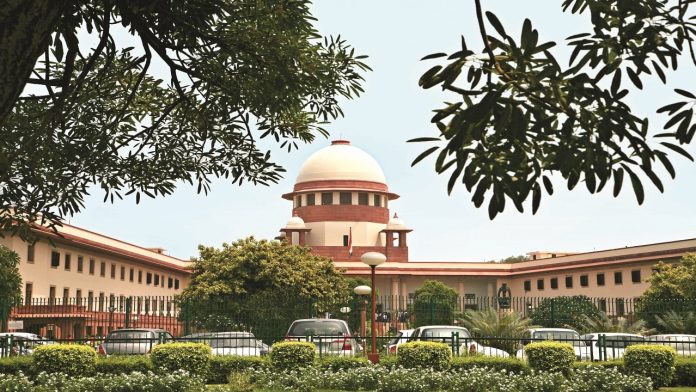By Sanjay Raman Sinha
The simmering tension between the centre and the judiciary found vent yet again in the courtroom and Parliament. It was not just one issue which was raised by the government. Apart from judges’ appointment, the centre has raked up other issues as well. This is being seen as a pressure tactic on the judiciary. Interestingly, the judiciary has not taken this lying down and given a stern reply to the government in the courtroom.
The most recent flashpoint occurred when Law Minister Kiren Rijiju linked pendency of cases with hearing of bail cases by the Supreme Court. The minister argued that the apex court should desist from hearing bail petitions as it undercuts time for other cases. The judiciary was quick to respond. During a hearing, Chief Justice DY Chandrachud didn’t mince words as he said that no matter is too small or insignificant to not to be heard. He added that if the judiciary doesn’t act and give relief in matters of personal liberty, then what are they doing here? He said this was their responsibility and how can they ignore the demand of the public for justice.
Later in the week, another matter was raised by the government in Parliament. This time it was of judicial holidays. Rijiju, tongue-in-cheek, advised courts to reduce their holidays and work longer hours. In his statement in the Rajya Sabha, Rijiju said there was a feeling among people that long court vacations were not very convenient for justice seekers. He added that it was his obligation and duty to convey the message or sense of this House to the judiciary.
Shortly after this “advice”, CJI Chandrachud announced that no Supreme Court bench would be available from December 17 till January 1 during the winter vacations. It was seen as a clear retort to the law minister’s unsolicited “advice”. However, it must be mentioned, that as a normal practice, there is no vacation bench in the Supreme Court during winter.
The Supreme Court has annual summer vacations of around seven weeks. It begins in late May and extends till July. The Court has a one-week break each for Dussehra and Diwali and a two-week one at the end of December. Several former chief justices had tried to reduce the vacation period and added benches during the recess.
The fact of the matter is that the doors of the Supreme Court are always open for urgent matters. If an important matter comes, it can always be mentioned before the vacation registrar. Taking consideration of the exigency, the vacation registrar informs the CJI about the case and he constitutes a special bench for hearing. In 2023, the courts won’t be active for about 180 days; this includes weekends and holidays.
However, vacation time is not all play and no work for the judges. While they relax and recuperate from their rigorous work schedule, they also use it for studying and writing judgments and in administrative work.
A few years back, Justice NV Ramana hit the nail on the head when he tried to demolish the vacation-myth. He argued that narratives created about the supposed easy life led by judges are difficult to swallow. Judges continue to work even during weekends and court holidays, he stressed, and in the process, miss out on many joys.
The government’s criticism of the judiciary is not new. However, what is different this time is that the attacks were being made from Parliament. This acquires a serious note. It is almost a policy decision. And the law minister was not alone in his attacks on the judiciary.
On December 7 when Jagdeep Dhankhar made his maiden speech as vice-president and Speaker of the Rajya Sabha, he targeted the judiciary. He referred to the National Judicial Commission Act and its rejection by the Supreme Court. Taking a dig at the judiciary, Dhankhar reminded it of the Laxman Rekha and said that if any bill passed by Parliament is annulled by the Supreme Court, it is an insult to the people’s mandate whose guardians are the Rajya Sabha and the Lok Sabha.
This is not the first time that the government has reminded the judiciary of the Laxman Rekha. It was the law minister himself who mentioned this and advised the judiciary not to cross it.
The appointment of judges was raked up yet again during the ongoing winter session when Rijiju mentioned the 70,000-case burden on the Supreme Court. Pendency would not be solved until a new system of judges’ appointment was put in place, he said in the House. Currently, the Supreme Court has 28 judges. The optimum strength is 34 judges. CJI Chandrachud has already said that the judiciary is overburdened because of the system and that it is difficult to find good lawyers to fill judicial vacancies in High Courts.
Way back in 1987, the Law Commission had noted the importance of manpower planning for the judiciary. The lack of an adequate number of judges means a greater workload per judge, which is leading to burnout and has the potential of affecting the quality of hearings and verdict. The need of the hour is a refurbished system which not only fast tracks judicial appointments at all levels, but also creates conditions for more appointment and nurturing of promising judicial officers.
Meanwhile, judges’ appointment issues along with other matters are used by the government to keep the pressure on and to put a check on judicial proactivity and activism. The judiciary, on the other hand, is fighting to keep governmental interference at bay and protect its independence and turf. In the process, the bad blood between both is smearing the reputation of constitutional offices and institutions.


